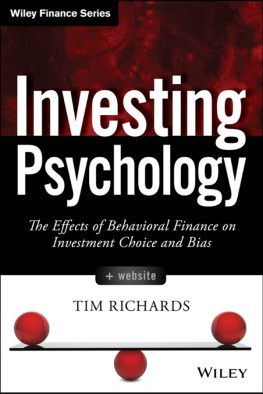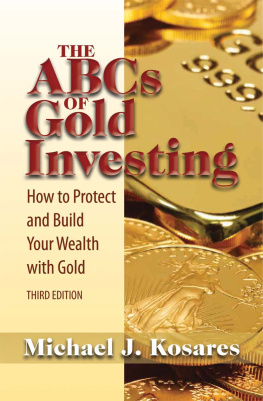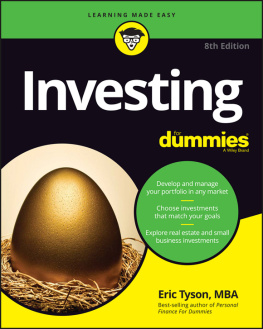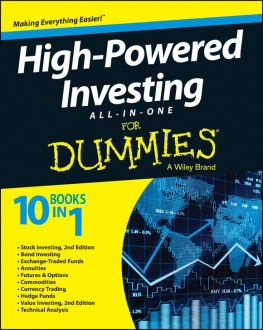Hale - Smarter Investing 3rd edn: Simpler Decisions for Better Results
Here you can read online Hale - Smarter Investing 3rd edn: Simpler Decisions for Better Results full text of the book (entire story) in english for free. Download pdf and epub, get meaning, cover and reviews about this ebook. year: 2013;2012, publisher: Pearson Education Limited, genre: Business. Description of the work, (preface) as well as reviews are available. Best literature library LitArk.com created for fans of good reading and offers a wide selection of genres:
Romance novel
Science fiction
Adventure
Detective
Science
History
Home and family
Prose
Art
Politics
Computer
Non-fiction
Religion
Business
Children
Humor
Choose a favorite category and find really read worthwhile books. Enjoy immersion in the world of imagination, feel the emotions of the characters or learn something new for yourself, make an fascinating discovery.

Smarter Investing 3rd edn: Simpler Decisions for Better Results: summary, description and annotation
We offer to read an annotation, description, summary or preface (depends on what the author of the book "Smarter Investing 3rd edn: Simpler Decisions for Better Results" wrote himself). If you haven't found the necessary information about the book — write in the comments, we will try to find it.
Hale: author's other books
Who wrote Smarter Investing 3rd edn: Simpler Decisions for Better Results? Find out the surname, the name of the author of the book and a list of all author's works by series.
Smarter Investing 3rd edn: Simpler Decisions for Better Results — read online for free the complete book (whole text) full work
Below is the text of the book, divided by pages. System saving the place of the last page read, allows you to conveniently read the book "Smarter Investing 3rd edn: Simpler Decisions for Better Results" online for free, without having to search again every time where you left off. Put a bookmark, and you can go to the page where you finished reading at any time.
Font size:
Interval:
Bookmark:

For Emma, Tilly and Betsy who make my life so rich.
This is the third edition of Smarter Investing and emerges as stock markets around the world return to levels last seen prior to the 2008 market collapse. Nothing material has changed in either investor psyches or market behaviour since the last edition four years ago. Investors who showed good discipline have made solid returns. Those who were carried away with market noise have generally had lower returns and may find themselves anxious about when and how to return to the market.
If you are concerned about how money is invested you should read Smarter Investing . If you are responsible for, or are the beneficiary of, moneys invested to meet your or your familys future needs, you must read Smarter Investing . It matters not whether you are a do-it-yourself investor or you are employing others to make investment decisions for you. In both cases you will be richer and more capable of critically judging the options available to you if you do read it. Whether you like it or not, the quality and enjoyment of your future is likely to be heavily determined by investment decisions. You fail yourself and your family if you leave those decisions naively to others or rely on chance.
Tim Hale has distilled, into less than 300 easy-to-read pages, the building blocks to help you to construct an investment portfolio that meets your needs. He puts together a solid case for low cost, low turnover investments that are easily understood. It is the most coherent and well constructed argument that I have come across in more than 40 plus years working in the financial services industry.
We know that investing is an uncertain activity. What Tim does is tell you why and how to build portfolios which have the greatest likelihood of achieving your goals. This does not mean that they come with a guarantee of portfolio performance. The financial world is too fickle for that. You might be the one in 50 or the one in 100 that will not be happy with your results. However, what you will learn from this book will leave you unsurprised by the portfolio returns and outcomes over time. You may be disappointed in the results but you should know that they are possible.
There are two distinct parts of Tims argument. One is concerned with helping you solve a very personal issue: how much investment risk you should take on in your investment portfolio. The second gives you a practical how to strategy for both constructing and managing your portfolio over time.
So how much investment risk should you take? Tim shows that you need to quantify and prioritise three competing expressions of risk in your life: risk required, risk capacity and risk tolerance (sometimes called risk appetite).
Risk required is the amount of risk associated with the return required to achieve your goals. You might want to live well in retirement, travel internationally on a regular basis, support your children and give generously to charity. You would not be unusual if you needed to take a reasonable amount of risk in your investments to do so. Most of us do not have sufficient existing or potential assets to meet our preferred future spending from cash-like returns. One of the basic laws of capitalism is that shares in businesses will, in the longer term, give you a higher return than lending money to a bank or government. So for those needing a higher return than cash or bonds, investment in shares is necessary. The downside is that there is a possibility that some of the companies you invest in might fail outright whilst others will vary in value and dividend over time. In simple terms shares should give a higher return than cash but with greater likelihood of variation above and below.
Risk capacity is the amount of money you could lose without putting your important short and long term goals at risk. Risk tolerance is best understood as the amount of financial risk you would naturally be comfortable with taking, all else being equal. Risk required and risk capacity vary with individual circumstances over time whereas risk tolerance is an enduring and generally persistent personal trait.
So heres the rub. Rarely do all three line up. More often than not the risk you need to take (risk required) is more than you could afford to take (risk capacity) and more than you normally prefer to take (risk tolerance). Which is the dominant one for you? What is the right mix? Many individuals would prefer to say this is just too hard. But you and your family will live the outcomes of these decisions and they must be made based on your values and priorities, not someone elses. Its just not fair to your family to leave it to someone else to decide. Worst of all do not leave it to a common risk profiler or portfolio picker. These are usually idiot quizzes offered by lazy life companies, indolent fund managers and apathetic financial advisers. More akin to the more lurid womens magazines astrology predictions than science, they seek to box unsuspecting investors into such groupings as You are a balanced investor seeking inflation protection, tax efficiency and regular income from the answers to half a dozen unrelated questions. They might just as easily say You are an Aquarian. You like new floats, holidays by the sea and highly liquid investments.
While it might seem a little difficult to define and establish the portfolio that best suits you, this turns out to be relatively straightforward compared to the challenges of managing that portfolio over time as markets move, the media bays and as a consequence your confidence waxes and wanes. More often than not individual investors make the mistake of buying at the top of the market and selling at the bottom. Tim first gives you the underlying disciplines to build a solid portfolio that meets your needs and secondly tells you how to minimise the behaviour that results in poor investment performance in the longer term.
The best thing about Tims arguments is that they are almost invariably supported by both hard evidence and intuitive common sense. In summary they are: invest in things you understand, use transparent, cheap and predictable products and control yourself when markets move strongly. Whether you manage your own investments or use a financial adviser your responsibility to yourself and your family demands that you read and make sense of his arguments.
Paul Resnik
Melbourne
August 2013
Paul Resnik has had many roles in the financial services industry over the last 40 years including setting up a national financial advisory practice in Australia, an asset management business, a life insurance company and many retirement income products. He has spent the last 20 years developing practical solutions to better match portfolios to investors needs. He is a co-founder of FinaMetrica which scientifically assesses financial risk tolerance for investors in more than 23 countries.
Having read Zoology at Oxford University, Tim went straight into the city, working for Standard Chartered in Hong Kong in their corporate banking division for four years. Following his MBA in 1991, he joined Chemical Global Investors in London a global investment boutique that was part of Chemical Bank. This later became part of Chase Asset Management, which in turn has subsequently been subsumed into JP Morgan Asset Management. He worked for Chase Manhattan until the turn of the millennium in London, Hong Kong and New York.
Driven by his experience of the difficulties that many investors face trying to invest sensibly, he set up Albion Strategic Consulting in 2001, which has forged a niche working with a small group of high-quality financial planning firms in the UK helping them to establish and manage a robust, risk-focused and low cost, passive approach to investing for their wealthy clients.
Font size:
Interval:
Bookmark:
Similar books «Smarter Investing 3rd edn: Simpler Decisions for Better Results»
Look at similar books to Smarter Investing 3rd edn: Simpler Decisions for Better Results. We have selected literature similar in name and meaning in the hope of providing readers with more options to find new, interesting, not yet read works.
Discussion, reviews of the book Smarter Investing 3rd edn: Simpler Decisions for Better Results and just readers' own opinions. Leave your comments, write what you think about the work, its meaning or the main characters. Specify what exactly you liked and what you didn't like, and why you think so.











![Tim Richards [Tim Richards] - Investing Psychology: The Effects of Behavioral Finance on Investment Choice and Bias, + Website](/uploads/posts/book/124122/thumbs/tim-richards-tim-richards-investing-psychology.jpg)

